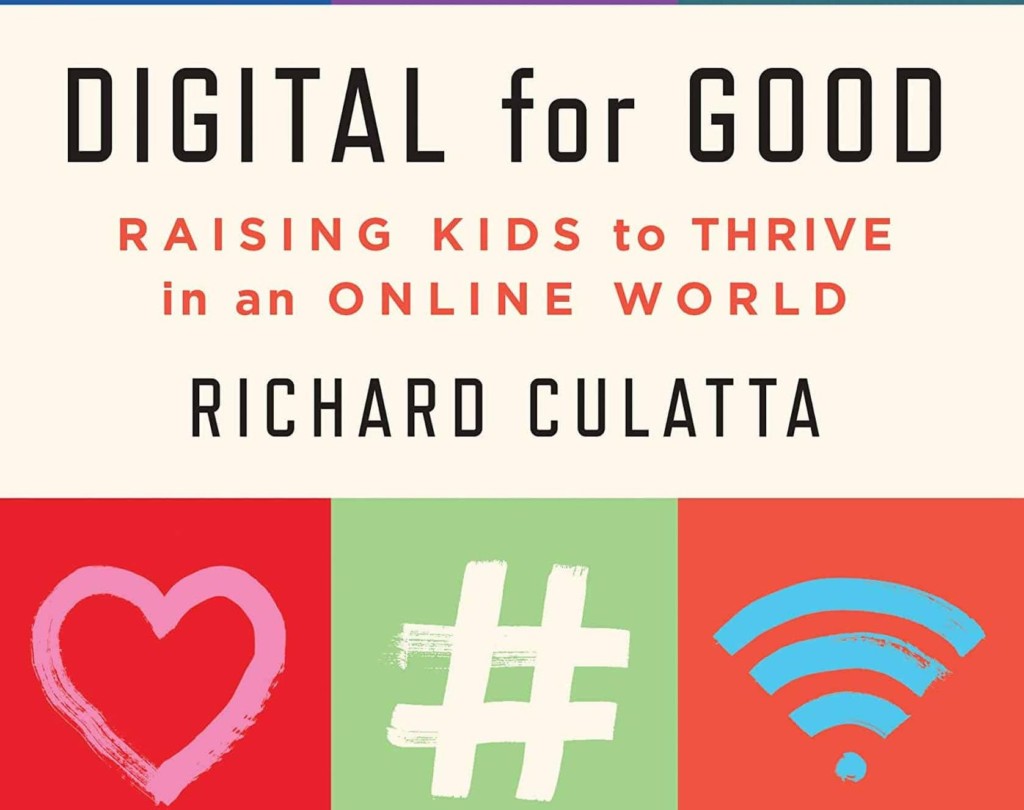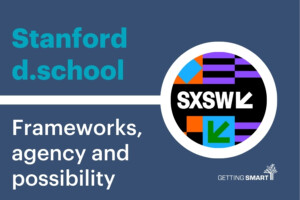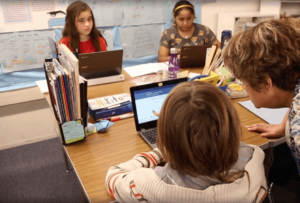Book Review: Digital for Good

I first met Richard Culatta years ago at SXSWEDU, listening to his impassioned plan to bring high-speed internet to not only schools but to homes for our students so all learners would have a chance at an equitable education. He was working then for President Obama’s Secretary of Education, Arne Duncan, also a former educator bringing forward their frontline experience with the widening opportunity gap. He also led the development of a National Education Technology Plan. Now, as CEO of ISTE, Culatta continues to make headway as a leader advocating for instructional technology best practices and the requisite policy work needed to implement at scale.
In Digital for Good: Raising Kids to Thrive in an Online World, Culatta takes a career’s worth of insight into how technology is impacting and impacted by educational interests and packages these ideas in a convincing and very personal narrative for anyone trying to serve our children’s best interests across a spectrum of outcomes: from the basic implications of digital influences on healthy parenting and teaching oversight all the way across the board to impacting our global culture. It’s this span that makes this volume immediately pragmatic. However, it’s his personal stories that show his work as not only endearing but credible. This gives Digital for Good shelflife. The examples of certain apps will likely change, but he’s careful to explain an underlying framework that is evergreen.
Culatta sets the stage in the opening chapter on a stark note: “With no expectation for acceptable behavior and near-complete anonymity, we have created an environment that is optimized for self-destruction.” He points out examples for how much the urgency for better digital citizenship may be unsavory to revisit since most readers will identify with the current state of our culture as a dire one. Culatta reflects on the most current trends that represent two sides of the coin: we need technology/technology is hurting our relationships with each other. The author says, “We have spent the last two decades excitedly finding ways to migrate all kinds of experiences to the digital world, but we haven’t stopped to ask how we will preserve our civil society as it also migrates there.”
The global implications may feel overwhelming, yet the book is organized in a manner that makes incremental progress possible with our own children or those that we teach and support in our schools. Whether we’re changing acceptable use policies for our districts and schools or coming up with a set of agreements for our households, Culatta does something necessary by speaking to both of these places where we can have the most influence on our own behavior as we guide those young minds who haven’t developed to the point of recognizing the inherent traits about what draws us to one technology or another. Both parties need support because as Culatta says:
“The migration from the physical to the digital world represents a fundamental shift in the lives of our children. The events that take place in the virtual world are not ancillary to their lives but are some of the most important elements of them. The limitations of the physical world will not shape or constrain the design of our children’s life events the way they did mine or yours.”
Culatta stays focused on the long-term and far-reaching gains of changing our priorities and harnessing the potential with new agreements and expectations of all parties, end-users and developers alike. He encourages us towards the same goals when he casts a vision for a shared philosophy, admonishing us all that, “We need to commit to establishing expectations for meaningful and civil online behaviors that will allow our children to not only be their best selves online, but bring out the best in others as well.”
The middle of the book is built upon his five areas where we all need to concurrently bolster our skills. This specificity is excellent as each chapter ends with Next Steps and Conversation Starters parents and educators alike can apply in their homes and schools. Here are the five attributes that Culatta has identified as essential for a healthy digital well-being for all:
Balanced. Balanced digital citizens participate in a variety of online activities and make informed decisions about how to prioritize their time in virtual and physical spaces.
Informed. Informed digital citizens evaluate the accuracy, perspective, and validity of digital media and have developed critical skills of curating information from the digital world.
Inclusive. Inclusive digital citizens are open to hearing and recognizing multiple viewpoints and engaging with others online with respect and empathy.
Engaged. Engaged digital citizens use technology and digital channels to solve problems and be a force for good in their physical and virtual communities.
Alert. Alert digital citizens are aware of their digital actions and know how to be safe and create safe spaces for others online.
As he discusses each attribute, he does an expert job considering his audience and making connections to applicable field research. With a call for more deliberate work on all fronts to improve our acceptance and usage of the tools we have grown so curious about or dependent upon but keeping users, vendors, and policymakers continually focusing on becoming more human, teacher, and firstly, student-centered:
When thinking about adapting and changing a school’s or family’s digital culture, it is important to do it with your kids and not to them; involve older kids, who will have suggestions based on habits developed from their own digital experiences.
In essence what Culatta does with Digital for Good is to reprioritize some of our known needs and show how to address them starting now, while reframing relatively recent concerns around the viral nature of digital fads and trends (recent in so much as we know tech is more like mushrooms than oak trees in their overnight development). But much like the Chinese proverb that, “The best time to plant a tree is twenty years ago. The second best time is now.” Culatta doesn’t use fear and uncertainty to persuade, but to inspire: “To become lifelong learners, provide for their families, and become leaders of our civil society, our children must learn how to responsibly use digital tools from a young age.” We should all be able to agree with that idea.
Whether found on the parenting shelf or your classroom desk Digital for Good is a timely message of hope, which is always the most inspiring leadership approach as Culatta coaches us all to work together to this common goal:
Being digital for good is a team sport. Families remain at the center of preparing their kids to be effective digital citizens, but they should not be expected to shoulder the burden alone. We should be continually identifying potentially missing members of the team and work in partnership with social platform providers, governments, and educational institutions to create an effective environment for our kids. This means helping these institutions understand what we’re expecting.
For more, see:
Stay in-the-know with innovations in learning by signing up for the weekly Smart Update.




0 Comments
Leave a Comment
Your email address will not be published. All fields are required.